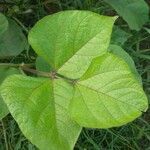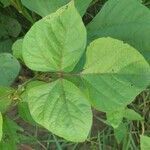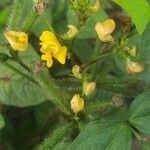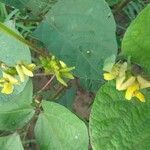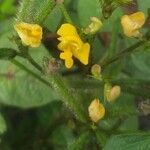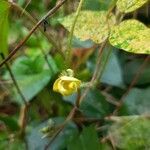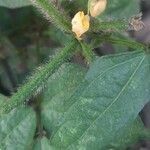Annual climbing or mostly erect herb, 0·2–0·6 m. tall.. Stems covered with long spreading yellow-brown or brown rather bristly hairs.. Leaflets 3, elliptic, rhomboid or ovate, the laterals somewhat oblique, 5–16 cm. long, 3–12 cm. wide, entire or 2–3-lobed, acuminate, broadly cuneate or rounded at the base, glabrous to bristly pilose on both surfaces, sometimes rather conspicuously 3-nerved from the base; petioles 5–21 cm. long; rhachis 1·5–4 cm. long; petiolules 3–6 mm. long; stipules peltate, ovate, rhomboid or obovate-oblong, 1–1·8 cm. long, 0·3–1 cm. wide, margins ciliate; stipels conspicuous, lanceolate.. Inflorescences axillary, 4–several(–25)-flowered; peduncle 2·5–9·5 cm. long; pedicels 2–3 mm. long; bracts ovate-lanceolate, 4–5 mm. long, ultimately deciduous; bracteoles linear-lanceolate or oblong, 4–7 mm. long, striate, subpersistent.. Calyx-tube glabrous, 3–4 mm. long; lobes narrowly triangular, 1·5–4 mm. long, ciliate, the upper pair joined to form a bifid lobe.. Standard greenish-yellow outside, sometimes pinkish inside, oblate, somewhat asymmetrically incurved at the apex, 1·2 cm. long, 1·6 cm. wide, emarginate, glabrous; wings yellow; keel green tinged reddish, incurved through 180°, the left-hand petal with a marked pocket.. Pod linear-cylindrical, 4–9 cm. long, 5–6 mm. wide, somewhat constricted between the (8–) 11–14 seeds, covered with dark brown short spreading bristly pubescence.. Seeds greenish, brown or blackish, oblong-cylindrical to globose or subcubic, longest dimension 2·5–4·2 mm., shorter dimension 2·5–3·2 mm., 2·3–2·8 mm. thick; hilum ± half the longest dimension; aril not developed; testa often with characteristic pattern of rather wavy raised ridges with close parallel riblets between, making the seed rough to the touch.
More
Annual herbs, erect, twining, or creeping, 20-60 cm tall. Stems hispid with brown spreading hairs. Stipules peltate, ovate, 0.8-1.2 cm, ciliate; petiole 5-21 cm; leaflets ovate, 5-16 × 3-12 cm, lateral ones ± oblique, ± sparsely pilose on both surfaces, sometimes 3-veined from base, base broadly cuneate or rounded, apex acuminate or acute. Racemes axillary, 4-to several flowered (up to 25). Bracteoles linear-lanceolate or oblong, striate. Calyx tube 3-4 mm, glabrous; lobes narrowly deltoid, 1.5-4 mm, upper 2 connate into a 2-fid lip. Standard yellow-green outside, sometimes pink inside, suboblate, ca. 1.2 × 1.6 cm, apex emarginate; wings yellow, ovate; keel falcate and incurved through 180°, green tinged with pink. Legumes linear-terete, 4-9 × ca. 0.6 cm, shortly hispid with pale brown hairs. Seeds 8-14, greenish or yellow-brown, shortly cylindric, 2.5-4 × 2.5-3 mm; hilum white. Fl. May-Jun, fr. Jun-Sep.
A herb. It is an upright hairy bean plant which can be 1 m tall. It has many branches. The leaves have 3 leaflets and are dark green. The leaves are on long leaf stalks. There are oval stipules at the base of the leaf. Flowers are pale yellow and small. They occur in bunches of 10-20 on the ends of long hairy flower stalks. Pods are black and straight. They do not have a beak. Pods contain 10-20 seeds which are usually green or golden yellow. They are smaller than black gram. The beans can be black. They have a flat white hilum. There are 2,000 varieties.
